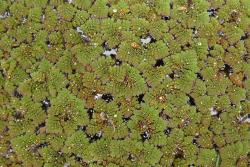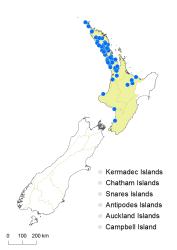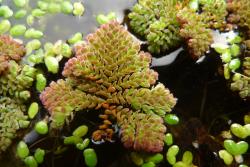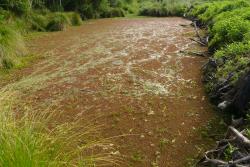- Taxon
- Weed
Aquatic fern, free-floating, forming extensive red or green mats. Plants usually broadly triangular or pentagonal or occasionally ovate or elliptic, 5–25 mm long, 4–25 mm wide; stems branching regularly, usually 2-pinnate, or sometimes 3-pinnate in the distal half of the lower pinnae; roots with fine lateral rootlets, 10–60 mm long. Leaves densely imbricate; upper lobe of leaves ovate to elliptic, 0.5–1.5 mm long, 0.3–0.8 mm wide, red or green, papillate; apices acute to obtuse; margins membranous and translucent. Sporocarps rarely produced; megasporocarps not seen; microsporocarps ovoid to spheroidal, covered in a membranous indusium, 1.0–2.0 mm long, 0.8–1.5 mm wide, apiculate, glabrous.
Azolla pinnata is readily distinguished from A. rubra by its more regular branching and by its roots with fine rootlets. It occurs only in the North Island.
North Island: Northland, Auckland, Volcanic Plateau, Taranaki, Southern North Island.
Altitudinal range: 0–440 m.
A widespread species of tropical and warm temperate Africa, Asia, Australia and New Caledonia, now naturalised in ponds and lakes throughout Northland, Auckland, Waikato and the Bay of Plenty, south to Kāwhia and Lake Ohakuri near Atiamuri. There are also specimens collected since 2009 from New Plymouth, Wanganui, Turakina, Otaki and Pekapeka, near Waikanae, suggesting that the plant is spreading southwards. It occurs from sea level up to 440 m at Lake Rerewhakaaitu in the Rotorua region. In Northland, it appears to be replacing the native A. rubra.
Grows on the surface of farm ponds, ornamental ponds, lakes, sluggish stream margins and in dune swamps. It often occurs with Spirodela, Wolffia, Lemna, Landoltia and Potamogeton cheesemanii, and occasionally with A. rubra, sometimes amongst Typha orientalis or sedges, or on open water.
NZ Weed & Pest Control Society (1969). Voucher: CHR 169486, 1969.
Reid et al. (2006) and Metzgar et al. (2007) showed that Azolla pinnata and the African A. nilotica form a sister clade to A. rubra, A. filiculoides and the other American species.







